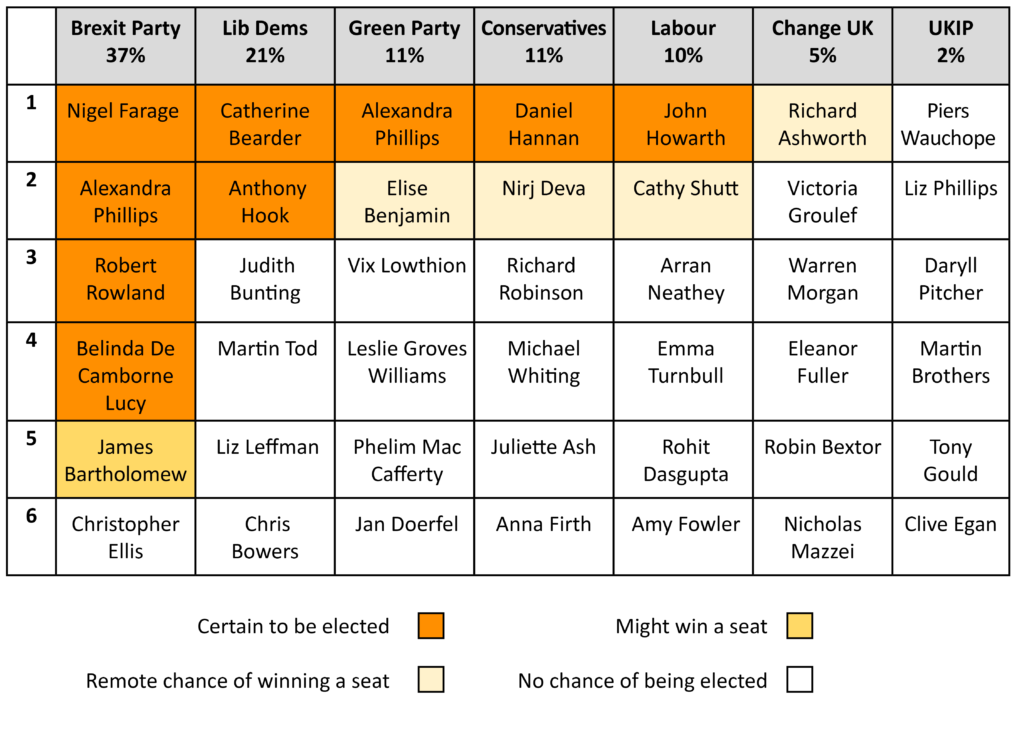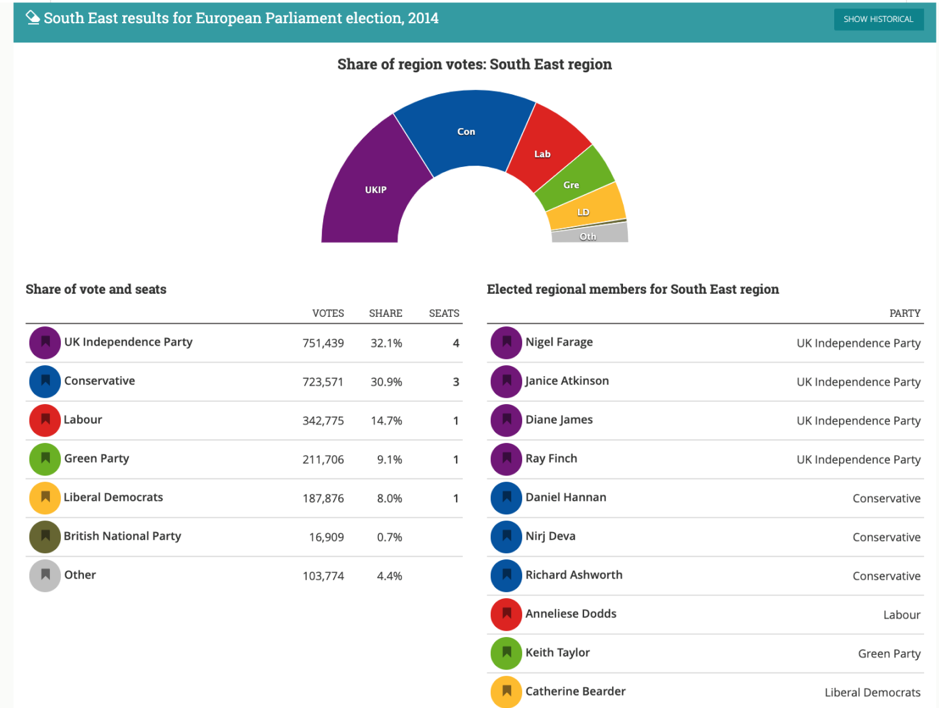European elections 2019: what will happen in England’s South East?
This is the UK’s biggest European regional constituency, returning ten MEPs. So it is the area where the most proportional results are feasible, and where smaller parties (those that can reach 6–8% support) have the best chance of gaining a seat. Traditionally a Conservative stronghold in all other elections, UKIP nonetheless came first here in 2014. That inheritance has now passed to the Brexit Party, which fields Nigel Farage as their top candidate and is now certain to win four seats here, and probably a fifth. Since Conservative support has apparently slumped, the Liberal Democrats are sure of winning a seat and should get two if current polls are right. The Tories, Greens and Labour should all get one seat each, and with small increments in support each (plus Change UK) might vie with the Brexit Party for the last of the region’s seats. With voters able to cast only a single vote for a party list in the election, which takes place on Thursday, 23 May, the Democratic Audit team reviews likely outcomes for the parties and the main potentially electable candidates.

The White Cliffs of Dover. Picture Tarik Haiga on Unsplash
The South East is a massive region that encircles London from the north, west and south down to the Channel coast. Historically, the rural South East is the core Conservative heartland, where many Cabinet ministers have their seats. Even at European elections the Tory vote traditionally held up, despite UKIP surges. In 2014 UKIP just topped the poll, gained 32% of the vote (1% more than the Conservatives) and (just) won four seats to the Tories’ three. In 2016 the region voted 52 to 48% to Leave the EU.
Nigel Farage has been an MEP here since 1999, as the top candidate for his former party UKIP. Now leader of the Brexit Party, he is sure to again top the poll in this region. National polling has put the Brexit Party as high as 34%, though with considerable variation between polls. In YouGov’s latest poll with a regional breakdown of figures for the South East, the Brexit Party are on 37%. That extra level of support guarantees them four seats and means they would probably pick up a fifth seat here.
With the region split fairly evenly in the referendum, and large pockets of strong Remain support found in cities like Brighton, there is plenty of scope for anti-Brexit parties to pick up votes and seats. Following strong local election results in some parts of the south, the Liberal Democrats have rapidly picked up support in the polls, moving from 8% and fifth place in 2014 up to second in the recent YouGov poll, with 21% support. Their incumbent MEP, Catherine Bearder, is certain of re-election and at this level the party would also be sure of gaining a second seat here.
The Greens have returned an MEP for the South East ever since this proportional representation system was introduced in 1999. Caroline Lucas established a firm foothold here, first as an MEP between 1999 and 2015, and then as MP for Brighton Pavilion. In 2014, the Green Party secured 9% of the vote, and one seat. They are currently polling 11%, so they should be guaranteed a seat. Only a small increment in support might even put them in contention for a second seat, but the party does not have that much upward momentum here.
Both the Labour party and Conservatives are being squeezed as both strong-Brexit and strong-Remain voters defect to parties offering clearer alternatives. The Conservatives are currently polling just 11% – tying with the Greens for fourth place. This is enough for them to retain one seat here, and their arch-Eurosceptic MEP Daniel Hannan, who tops their list, should retain his seat safely. Like the Greens, the Conservatives need only a few percent more votes on polling day itself to have a chance of retaining a second of their three current seats.
Labour don’t have as far to fall in the South East, having won 15% of votes in 2014, and only a single MEP. Their support is also being squeezed, with YouGov giving them 10%. This is enough to keep their one seat comfortably, but no more. Suggestions earlier in the campaign that they could capitalise on Tory weaknesses, and that changing demographics in the South East favour them, have faded in recent weeks.
At the start of the election period, the South East was seen as a good prospect for the new Remain-supporting party Change UK to win a seat. It remains their best-chance region and a ComRes poll in early May put them at 9% here. However, YouGov more recently put them on 5%, with strong-Remain support gravitating towards the Lib Dems and Greens. Change UK need to achieve 8% support to get back in the race for a seat, and their national picture has been weakening. Finally, as elsewhere, what is left of UKIP has faded entirely from the picture, and they are polling only 2%.
All the parties clutter up the ballot paper here by listing ten candidates, even though the lower ranked ones cannot possibly win a seat under proportional representation. So we show a cut-down list below in Figure 1. (For a full candidate list of all parties and independents see here.) Voters can only vote for a single party list, not specific candidates, by marking a single X on the ballot paper. In making up their minds which party list to support, voters need only pay attention to the fourteen candidates in the shaded boxes here.
Figure 1: Main party candidates and possible winners from YouGov polling in mid-May, for the South East region (ten seats)

Polling data YouGov published 19 May (fieldwork 8–17 May).
To find details of all the local candidates, and to locate your polling station, visit our Democratic Dashboard site and simply put in your postcode. The site also has full details of other recent elections in your local area.
Below we list a summary of any candidate in Figure 1 with some chance of being elected, and point to their social media sites, which can show you something of what each candidate is like as a person. At the bottom of this article we also give the full 2014 results for the South East.
Which candidates could be elected in the South East in 2019?
BREXIT PARTY are in a dominant position in the polls, and the presences of Farage at the top of their list, plus the large number of seats available, make this a region where the Brexit Party should do well. They are sure to win four seats, and are front-runners in recent polling for the region’s fiercely contested last seat, which would give them five.
- Nigel Farage (Twitter: @Nigel_Farage) has been an MEP for UKIP here since 1999. His profile and voting record on Votewatch.eu are here. He ranks 745th out of 749 MEPs for attendance in the European Parliament. One of the founding members of UKIP, he was leader of the party three times – in 2006–2009, 2010–September 2016 and in October–November 2016. He left the party in 2018, establishing his new party, the Brexit Party, in early 2019. He appears to be in sole control of the new party, which has no members, NEC or other usual party structures in place, but has attracted 125,000 ‘supporters’ paying a fee to belong.
- Alexandra Phillips (Twitter: @BrexitAlex) was UKIP’s head of media and an aide to Farage before joining the Conservative Party after the referendum in 2016, and then defecting to the Brexit Party on its formation. (She is not to be confused with the leading Green Party candidate with the same name.)
- Robert Rowland (Twitter: @RowlandBrexitSE) is a fund manager and principal in an investment firm, Bowman Capital.
- Belinda De Lucy (Twitter @BelindadeLucy) is a prominent campaigner with recent pro-Brexit groups such as ‘Ladies for Leave’, and a trustee of the charity ‘Give us Time’ founded by Liam Fox MP.
- James Bartholomew (Twitter: @JGBartholomew) is a journalist, columnist and author, who has written for The Telegraph. He is highly critical of all state-run welfare, has argued that the British welfare state has done more harm than good, and believes that the NHS should be replaced with an insurance system.
LIBERAL DEMOCRATS are doing well here with momentum from the local elections, and the party’s incumbent MEP is certain to be re-elected. If they maintain their poll rating the party should win two seats.
- Catherine Bearder (Twitter: @catherinemep) was first elected as an MEP in 2009, and was the sole Lib Dem winning a seat in 2014. You can read her Votewatch.eu profile here. She campaigns on environmental and wildlife protection issues.
- Anthony Hook (Twitter: @antonyhook) is a Kent county councillor for Faversham and a barrister. He also stood as second on the Lib Dem list in 2014.
CONSERVATIVES – this should be solid Conservative territory, but on current polling they look likely to drop from three MEPs to just one. If their support is more resilient on polling day than YouGov suggests, however, they could be contenders for the region’s last seat as well.
- Daniel Hannan (Twitter: @DanielJHannan) was first elected as an MEP in 1999. His voting record and profile from Votwewatch.eu are here. One of the most high-profile Conservative MEPs, he has campaigned on Eurosceptic causes for decades. He appears on TV a lot and writes regularly for the Telegraph and other publications.
- Nirj Deva (Twitter: @NirjDeva) has been an MEP for the South East since 1999. His voting record at Votewatch.eu is here. He was previously an MP for Brentford and Isleworth between 1992 and 1997.
GREEN PARTY – The party’s incumbent MEP (Keith Taylor, who replaced Caroline Lucas after she was elected to Westminster in 2015) is standing down. His replacement at the top of their list, Alexandra Phillips, should retain the seat for the Greens on current polling. Again, any increment of support might give them a chance for a second seat.
- Alexandra Phillips (Twitter: @alexforeurope) is a former researcher for the two previous Green MEPs, Keith Taylor and Caroline Lucas. She is campaign coordinator for the Green party, as well as a local councillor in Brighton. (Not to be confused with the Brexit Party candidate of the same name.)
- Elise Benjamin (Twitter: @EliseDB) is a prominent Green campaigner and was formerly a councillor in Oxford.
LABOUR have had a single MEP here since 2004 (and two prior to that). On current polling they are sure to retain their existing seat. If their support proves stronger on polling day than current polls suggest, they could be contenders for a second seat also.
- John Howarth (Twitter: @JohnHowarth1958) became an MEP when Annalise Dodds(elected in 2014) was elected to Westminster in the June 2017 election. His voting record and Votewatch.eu profile are here.
- Cathy Shutt is an academic specialising in international development at Sussex University. You can see her talking about climate change here.
CHANGE UK – Despite some promising early polls, and an experienced and incumbent MEP as their top candidate, the party are polling just too low to pick up a seat here. They could be a contender for the region’s last seat only if their support goes up from 5% to around 8%.
- Richard Ashworth (Twitter: @RichardAshMEP) was a Conservative MEP for the South East from 2004, but had the whip withdrawn when he voted in the European Parliament that the UK government had not made enough progress in Brexit negotiations. You can read why he stand for Change UK here, and find his European Parliament voting record is here.
UKIP – The party looks set to lose all four seats it won here in 2014. Three of its MEPs have left the party, and the fourth is not re-standing.
- Piers Wauchope (Twitter: @PiersUkip) is a barrister, a long-term UKIP campaigner and candidate, and a member of the party’s National Executive Committee.
Figure 1: 2014 European Parliament election results for the South East and MEPs

Source: Democratic Dashboard. Order elected and current status: 1. Nigel Farage (elected UKIP, now Brexit Party); 2. Daniel Hannan (Conservative); 3. Janice Atkinson (elected UKIP, now Independent); 4. Nirj Deva (Conservative); 5. Anneliese Dodds (Labour, replaced by John Howarth in 2017); 6 Diane James (elected UKIP, now Independent); 7 Richard Ashworth (elected Conservative, now standing for Change UK); 8 Keith Taylor (Green); 9 Catherine Bearder (Lib Dem); 10 Ray Finch (UKIP).
Read more about how the European Parliament elections work:





 Democratic Audit's core funding is provided by the Joseph Rowntree Charitable Trust. Additional funding is provided by the London School of Economics.
Democratic Audit's core funding is provided by the Joseph Rowntree Charitable Trust. Additional funding is provided by the London School of Economics.